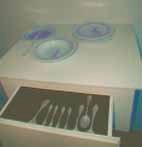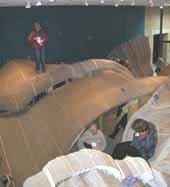American Craft Council Conference
Houston Texas
Pre-conference Tour
A whistle stop tour of over eleven different museums and galleries in Houston enables you to develop a clear view of the state of contemporary craft particularly its curation and status. It was striking how differently craft was treated in each of these spaces.

First stop was the Hiram Butler Gallery and Darryl Lauster's "A Seat at the Table Exhibition (Left)". This in part paid homage to craft makers of the past by dipping early 20th century cuttlery and crockery in paint with iconic images e.g. statue of liberty etc. Here craft was appropriated as part of a language.
The Rice Gallery part of Rice University provides gallery space for contemporary artists to create innstallations on site. The current exhibition "Rip Curl Canyon" by designers Gaston Nogues and Benjamin Ball evokes "a mythical location in the American West where land and water collide" (Below). This is a
fan
 tastic installation where visitors are unusually for an art gallery encouraged to climb on and under and become part of the experience. Is this art or is this craft? Certainly on one level and particularly to a viewer it really doesnt matter. The question however is of relevance in economic and pedagogical terms. In this space less commercial work which is perhaps more challenging can be produced. One curator did abruptly suggest that the question was just pornography!
tastic installation where visitors are unusually for an art gallery encouraged to climb on and under and become part of the experience. Is this art or is this craft? Certainly on one level and particularly to a viewer it really doesnt matter. The question however is of relevance in economic and pedagogical terms. In this space less commercial work which is perhaps more challenging can be produced. One curator did abruptly suggest that the question was just pornography!The Museum of Fine Art had a different approach to this question. In a rare move all the curators had worked together to jointly curate an exhibition on memory and here we were able to see craft objects, for example jewellery by Wendy Ramshaw sitting alongside painting and new media - all with equal status. This was refreshing and an approach that other museums should be encouraged to adopt.
Opening keynote speaker Sculptor Martin Puryear suggested that craft suffers from a semantic indeterminacy however it survives because of the deeper longing that we have to live with objects that provide a nourishing intimacy. He preferred the term artisan to craft. As appears to be custom at craft conferences these days Martin announced that he himself was not a craftsperson and was a little bewildered as to why he had been asked to speak! He effectively laid down the gauntlet however by reminding us that when critics suggested painting was dead - it was a call to pick up brushes and produce work of the highest quality. Certainly as some have suggested recently that "Craft is Dead" then perhaps similarly we should respond by producing some outstanding examples of craft that more clearly articulate what is so special and unique about the discipline.
Great commentary! The analogy of craft being ‘pornography’ was amusing, never heard it being referred to in that way
ReplyDeleteIt would be interesting to know if the curator’s treated painting and craft with the same integrity? Should we be talking to the curator of the Museum of Fine Art about how s/he approached the exhibition and what the feedback from this work has been?
What about other aspects of the conference, which speakers had an interesting ‘voice’? It would be good to hear more.
When considering your comments Sandra, I couldn't help but go back to some of the comments Frances Stevenson (March 2006) made while attending the Radical Craft conference. Frances said "Constance Adams' (NASA) presentation...presented 'Crafting the Mothership, space architecture'... explain[ing] that Earth is ONE complex organism and in order for earth to survive the organism must propagate. If earth is the mothership then spacecrafts should be sent out to propagate other environments.
ReplyDeleteFrances' blog went on to note the,
"talk was great as it involved radical ideas in terms of how space exploration has forced 'makers' to rethink how they get something to work. She highlighted structures like soil, crystals and grains. Growing and living structures that are necessary for life. Structures that demonstrate the movement of life. What was really interesting is that she highlighted the need for natural methods and materials being used in order to sustain life, and how future visions look back to traditional roots."
Now, my question is whether these or a similar issues were raised and discussed during 'Reshaping the Future of Craft'? Is it possible to identify shared themes or strands between the two events?
Hi Louise
ReplyDeleteThe Director of the Museum of Fine Art Peter Marzio also spoke at the event and it was clear that he was behind the moves to give an equal status to craft alongside fine art. His main comment was that the Museums need craft more than craft needs the museums!